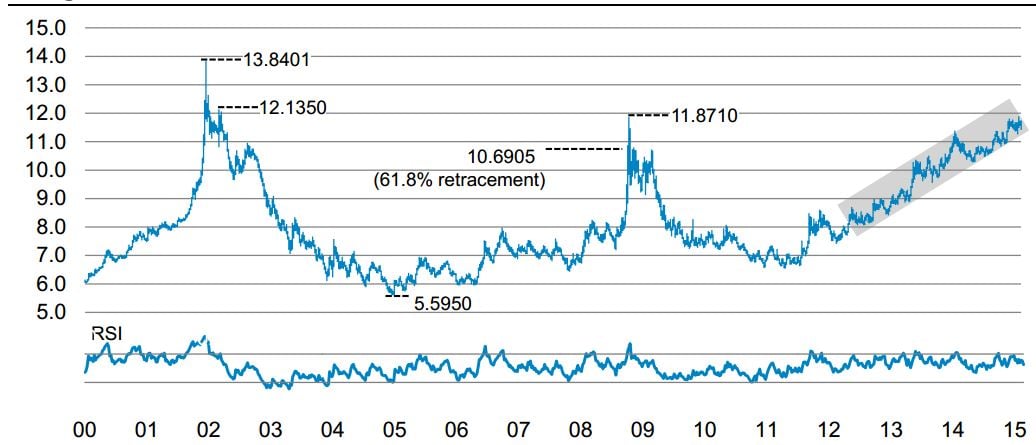South African Rand Forecast to Fall as USD Demand Set to Grow
- Written by: Gary Howes
-

The South African Rand exchange rate complex (ZAR) is forecast to weaken through the course of 2015.
“ZAR volatility has become increasingly correlated to US Treasury yields with concerns building around future Fed hikes, which may result in SAGB volatility and therefore ZAR weakness.” – Morgan Stanley.
Driving the soft tone will be the mixture of a rising bond yields, demand for US dollars, soft inflation and under-par local data.
However, upward inflationary pressure at the end of the year should step in to arrest any steep declines in the currency and save the ZAR from any drastic falls.
Before looking at the latest research concerning the rand’s future, here are the spot market rates at the time of writing.
- The pound to SA rand exchange rate is 0.38% higher on a day-to-day comparison at 18.1396.
- The euro to South African rand is unchanged at 13.1456.
- The US dollar to Rand exchange rate is meanwhile 0.40 pct higher at 11.8070.
NB: The above quotes and graphic representations below are taken off the wholesale markets. Your bank will affix a spread at their discretion when passing on currency. However, an independent FX provider will seek to undercut your bank's offer, thereby delivering up to 5% more currency in some instances. Find out more.
Near-Term Relief as Technical Barrier Resists the Dollar
The analyst research we present in this piece advocates for a longer-term bearish scenario dominating the South African currency – this is discussed further down.
However, those watching the ZAR need to be aware that near term technical resistance against the US dollar could well see the South African unit stage a relief rally.
Relief against the USD will also help the South African unit against the euro and pound sterling so the GBP/ZAR and EUR/ZAR pairings could also struggle somewhat.
Technical studies from Morgan Stanley, the global investment bank, shows USDZAR briefly created a new 10-year high of 11.8926 – which is significant:
“Breaking back above this level is key for the long-term uptrend. USDZAR has continued to trade within a channel since 2012, with the lower end around 11.30.
“Market participants are likely to keep USDZAR above this channel, but a clear break below the 11.20 area could open up some downside risks for the pair.”
Longer-Term Forecasts See USD/ZAR Trekking Lower
In the same research note Morgan Stanley tell clients they see the ZAR edging lower through 2015 to reach 12.30 by year-end.
By the end of 2016 further declines to 12.50 are expected.
“ZAR volatility has become increasingly correlated to UST yields with concerns building around future Fed hikes, which may result in SAGB volatility and therefore ZAR weakness. In addition, further weakness in gold prices relative to oil suggests further terms of trade weakness for ZAR,” says a forecast note issued by Morgan Stanley.
Bank of America: Inflation to Keep ZAR Losses Contained
Also advocating for ZAR losses are the team at Bank of America Merrill Lynch Global Research.
However, BofA have come forward with a shallower currency forecast noting the limit to ZAR’s downside seen at 11.50, as opposed to 12.30, USDZAR by year-end.
A rate of 11.50 is seen at mid-year.
According to analyst Matthew Sharratt at BofA South Africa’s high inflation profile should keep interest rates high, ensuring currency outflows are restricted:
“In 2H15 it would become increasingly clear inflation bottomed, in our view, triggering a decline in the real repo rate and discussions about continuing interest rate normalization.
“We expect the next 25bp hike to 6.00% in January 2016, with a cumulative 125bp of tightening to 7.00% by year-end 2016.”
Higher interest rates = stronger currencies.
Why the Dollar’s Rise Will Keep the Rand Pressured
While domestic events in SA are often cited for the value of the currency, it would be a mistake to ignore the external power of the US dollar which is currently seen in a trend of appreciation.
Hans Redeker at Morgan Stanley tells us interest rate rises in the United States will impact South Africa in particular:
- USD strength results from higher US Treasury bond yields.
- Risks to US yield have shifted to the upside, we think.
- US bond yields have stayed low as domestic capital demand has been outpaced by foreign capital inflows, tipping the balance between capital demand and supply towards lower rates.
- Meanwhile, US labor market conditions have strengthened as illustrated by the Jolts report, which has rarely shown such a large gap between job openings and actual hirings. Looking only at US factors, US bond yields should move higher.
- Investments in local currency denominated debt may flee when US bond yields spike higher.
Using this framework, Morgan Stanley find Mexico, Hungary, Malaysia, Peru, Indonesia and South Africa as most vulnerable.

